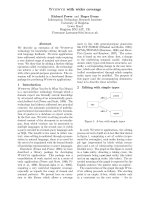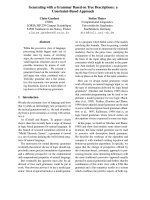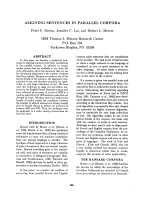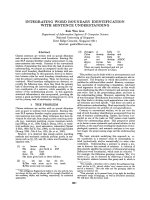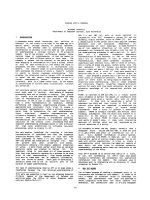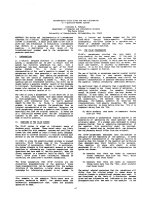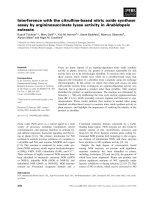Báo cáo khoa học: "Paraphrasing with Bilingual Parallel Corpora" pot
Bạn đang xem bản rút gọn của tài liệu. Xem và tải ngay bản đầy đủ của tài liệu tại đây (188.94 KB, 8 trang )
Proceedings of the 43rd Annual Meeting of the ACL, pages 597–604,
Ann Arbor, June 2005.
c
2005 Association for Computational Linguistics
Paraphrasing with Bilingual Parallel Corpora
Colin Bannard Chris Callison-Burch
School of Informatics
University of Edinburgh
2 Buccleuch Place
Edinburgh, EH8 9LW
{c.j.bannard, callison-burch}@ed.ac.uk
Abstract
Previous work has used monolingual par-
allel corpora to extract and generate para-
phrases. We show that this task can be
done using bilingual parallel corpora, a
much more commonly available resource.
Using alignment techniques from phrase-
based statistical machine translation, we
show how paraphrases in one language
can be identified using a phrase in another
language as a pivot. We define a para-
phrase probability that allows paraphrases
extracted from a bilingual parallel corpus
to be ranked using translation probabili-
ties, and show how it can be refined to
take contextual information into account.
We evaluate our paraphrase extraction and
ranking methods using a set of manual
word alignments, and contrast the qual-
ity with paraphrases extracted from auto-
matic alignments.
1 Introduction
Paraphrases are alternative ways of conveying the
same information. Paraphrases are useful in a num-
ber of NLP applications. In natural language gen-
eration the production of paraphrases allows for the
creation of more varied and fluent text (Iordanskaja
et al., 1991). In multidocument summarization the
identification of paraphrases allows information re-
peated across documents to be condensed (McKe-
own et al., 2002). In the automatic evaluation of
machine translation, paraphrases may help to alle-
viate problems presented by the fact that there are
often alternative and equally valid ways of translat-
ing a text (Pang et al., 2003). In question answering,
discovering paraphrased answers may provide addi-
tional evidence that an answer is correct (Ibrahim et
al., 2003).
In this paper we introduce a novel method for ex-
tracting paraphrases that uses bilingual parallel cor-
pora. Past work (Barzilay and McKeown, 2001;
Barzilay and Lee, 2003; Pang et al., 2003; Ibrahim et
al., 2003) has examined the use of monolingual par-
allel corpora for paraphrase extraction. Examples
of monolingual parallel corpora that have been used
are multiple translations of classical French novels
into English, and data created for machine transla-
tion evaluation methods such as Bleu (Papineni et
al., 2002) which use multiple reference translations.
While the results reported for these methods are
impressive, their usefulness is limited by the scarcity
of monolingual parallel corpora. Small data sets
mean a limited number of paraphrases can be ex-
tracted. Furthermore, the narrow range of text gen-
res available for monolingual parallel corpora limits
the range of contexts in which the paraphrases can
be used.
Instead of relying on scarce monolingual parallel
data, our method utilizes the abundance of bilingual
parallel data that is available. This allows us to cre-
ate a much larger inventory of phrases that is appli-
cable to a wider range of texts.
Our method for identifying paraphrases is an
extension of recent work in phrase-based statisti-
cal machine translation (Koehn et al., 2003). The
essence of our method is to align phrases in a bilin-
gual parallel corpus, and equate different English
phrases that are aligned with the same phrase in the
other language. This assumption of similar mean-
597
Emma burst into tears and he tried to comfort
her, saying things to make her smile.
Emma cried, and he tried to console her, adorn-
ing his words with puns.
Figure 1: Using a monolingal parallel corpus to ex-
tract paraphrases
ing when multiple phrases map onto a single for-
eign language phrase is the converse of the assump-
tion made in the word sense disambiguation work of
Diab and Resnik (2002) which posits different word
senses when a single English word maps onto differ-
ent words in the foreign language (we return to this
point in Section 4.4).
The remainder of this paper is as follows: Section
2 contrasts our method for extracting paraphrases
with the monolingual case, and describes how we
rank the extracted paraphrases with a probability
assignment. Section 3 describes our experimental
setup and includes information about how phrases
were selected, how we manually aligned parts of the
bilingual corpus, and how we evaluated the para-
phrases. Section 4 gives the results of our evalua-
tion and gives a number of example paraphrases ex-
tracted with our technique. Section 5 reviews related
work, and Section 6 discusses future directions.
2 Extracting paraphrases
Much previous work on extracting paraphrases
(Barzilay and McKeown, 2001; Barzilay and Lee,
2003; Pang et al., 2003) has focused on finding iden-
tifying contexts within aligned monolingual sen-
tences from which divergent text can be extracted,
and treated as paraphrases. Barzilay and McKeown
(2001) gives the example shown in Figure 1 of how
identical surrounding substrings can be used to ex-
tract the paraphrases of burst into tears as cried and
comfort as console.
While monolingual parallel corpora often have
identical contexts that can be used for identifying
paraphrases, bilingual parallel corpora do not. In-
stead, we use phrases in the other language as piv-
ots: we look at what foreign language phrases the
English translates to, find all occurrences of those
foreign phrases, and then look back at what other
English phrases they translate to. We treat the other
English phrases as potential paraphrases. Figure 2 il-
lustrates how a German phrase can be used as a point
of identification for English paraphrases in this way.
Section 2.1 explains which statistical machine trans-
lation techniques are used to align phrases within
sentence pairs in a bilingual corpus.
A significant difference between the present work
and that employing monolingual parallel corpora, is
that our method frequently extracts more than one
possible paraphrase for each phrase. We assign a
probability to each of the possible paraphrases. This
is a mechanism for ranking paraphrases, which can
be utilized when we come to select the correct para-
phrase for a given context . Section 2.2 explains how
we calculate the probability of a paraphrase.
2.1 Aligning phrase pairs
We use phrase alignments in a parallel corpus as
pivots between English paraphrases. We find these
alignments using recent phrase-based approaches to
statistical machine translation.
The original formulation of statistical machine
translation (Brown et al., 1993) was defined as a
word-based operation. The probability that a foreign
sentence is the translation of an English sentence is
calculated by summing over the probabilities of all
possible word-level alignments, a, between the sen-
tences:
p(f |e) =
a
p(f , a|e)
Thus Brown et al. decompose the problem of de-
termining whether a sentence is a good translation
of another into the problem of determining whether
there is a sensible mapping between the words in the
sentences.
More recent approaches to statistical translation
calculate the translation probability using larger
blocks of aligned text. Koehn (2004), Tillmann
(2003), and Vogel et al. (2003) describe various
heuristics for extracting phrase alignments from the
Viterbi word-level alignments that are estimated us-
ing Brown et al. (1993) models. We use the heuris-
tic for phrase alignment described in Och and Ney
(2003) which aligns phrases by incrementally build-
ing longer phrases from words and phrases which
have adjacent alignment points.
1
1
Note that while we induce the translations of phrases from
598
what is more, the relevant cost dynamic is completely under control
im übrigen ist die diesbezügliche kostenentwicklung völlig unter kontrolle
we owe it to the taxpayers to keep in checkthe costs
wir sind es den steuerzahlern die kosten zu habenschuldig unter kontrolle
Figure 2: Using a bilingual parallel corpus to extract paraphrases
2.2 Assigning probabilities
We define a paraphrase probability p(e
2
|e
1
) in terms
of the translation model probabilities p(f |e
1
), that
the original English phrase e
1
translates as a partic-
ular phrase f in the other language, and p(e
2
|f), that
the candidate paraphrase e
2
translates as the foreign
language phrase. Since e
1
can translate as multiple
foreign language phrases, we sum over f :
ˆe
2
= arg max
e
2
=e
1
p(e
2
|e
1
) (1)
= arg max
e
2
=e
1
f
p(f|e
1
)p(e
2
|f) (2)
The translation model probabilities can be com-
puted using any standard formulation from phrase-
based machine translation. For example, p(e|f)
can be calculated straightforwardly using maximum
likelihood estimation by counting how often the
phrases e and f were aligned in the parallel corpus:
p(e|f) =
count(e, f)
e
count(e, f)
(3)
Note that the paraphrase probability defined in
Equation 2 returns the single best paraphrase, ˆe
2
, ir-
respective of the context in which e
1
appears. Since
the best paraphrase may vary depending on informa-
tion about the sentence that e
1
appears in, we extend
the paraphrase probability to include that sentence
S:
ˆe
2
= arg max
e
2
=e
1
p(e
2
|e
1
, S) (4)
word-level alignments in this paper, direct estimation of phrasal
translations (Marcu and Wong, 2002) would also suffice for ex-
tracting paraphrases from bilingual corpora.
a million, as far as possible, at work, big business,
carbon dioxide, central america, close to, concen-
trate on, crystal clear, do justice to, driving force,
first half, for the first time, global warming, great
care, green light, hard core, horn of africa, last re-
sort, long ago, long run, military action, military
force, moment of truth, new world, noise pollution,
not to mention, nuclear power, on average, only too,
other than, pick up, president clinton, public trans-
port, quest for, red cross, red tape, socialist party,
sooner or later, step up, task force, turn to, under
control, vocational training, western sahara, world
bank
Table 1: Phrases that were selected to paraphrase
S allows us to re-rank the candidate paraphrases
based on additional contextual information. The ex-
periments in this paper employ one variety of con-
textual information. We include a simple language
model probability, which would additionally rank
e
2
based on the probability of the sentence formed
by substiuting e
2
for e
1
in S. A possible extension
which we do not evaluate might be permitting only
paraphrases that are the same syntactic type as the
original phrase, which we could do by extending the
translation model probabilities to count only phrase
occurrences of that type.
3 Experimental Design
We extracted 46 English phrases to paraphrase
(shown in Table 1), randomly selected from those
multi-word phrases in WordNet which also occured
multiple times in the first 50,000 sentences of our
bilingual corpus. The bilingual corpus that we used
599
Alignment Tool
.
kontrolle
unter
völlig
kostenentwickl
diesbezügliche
die
ist
übrigen
im
.
control
under
completely
is
dynamic
cost
relevant
the
,
more
is
what
(a) Aligning the English phrase to be paraphrased
haben
zu
kontrolle
unter
kosten
die
schuldig
steuerzahlern
den
es
sind
wir
.
check
in
costs
the
keep
to
taxpayers
the
to
it
owe
we
Alignment Tool
(b) Aligning occurrences of its German translation
Figure 3: Phrases highlighted for manual alignment
was the German-English section of the Europarl cor-
pus, version 2 (Koehn, 2002). We produced auto-
matic alignments for it with the Giza++ toolkit (Och
and Ney, 2003). Because we wanted to test our
method independently of the quality of word align-
ment algorithms, we also developed a gold standard
of word alignments for the set of phrases that we
wanted to paraphrase.
3.1 Manual alignment
The gold standard alignments were created by high-
lighting all occurrences of the English phrase to
paraphrase and manually aligning it with its Ger-
man equivalent by correcting the automatic align-
ment, as shown in Figure 3a. All occurrences of
its German equivalents were then highlighted, and
aligned with their English translations (Figure 3b).
The other words in the sentences were left with their
automatic alignments.
3.2 Paraphrase evaluation
We evaluated the accuracy of each of the para-
phrases that was extracted from the manually
aligned data, as well as the top ranked paraphrases
from the experimental conditions detailed below in
Section 3.3. Because the acccuracy of paraphrases
can vary depending on context, we substituted each
Under control
This situation is in check in terms of security.
This situation is checked in terms of security.
This situation is curbed in terms of security.
This situation is curb in terms of security.
This situation is limit in terms of security.
This situation is slow down in terms of security.
Figure 4: Paraphrases substituted in for the original
phrase
set of candidate paraphrases into between 2–10 sen-
tences which contained the original phrase. Figure 4
shows the paraphrases for under control substituted
into one of the sentences in which it occurred. We
created a total of 289 such evaluation sets, with a
total of 1366 unique sentences created through sub-
stitution.
We had two native English speakers produce
judgments as to whether the new sentences pre-
served the meaning of the original phrase and as to
whether they remained grammatical. Paraphrases
that were judged to preserve both meaning and
grammaticality were considered to be correct, and
examples which failed on either judgment were con-
sidered to be incorrect.
In Figure 4 in check, checked, and curbed were
600
under control checked, curb, curbed, in check, limit, slow down
sooner or later at some point, eventually
military force armed forces, defence, force, forces, military forces, peace-keeping personnel
long ago a little time ago, a long time, a long time ago, a lot of time, a while ago, a while back,
far, for a long time, for some time, for such a long time, long, long period of time, long
term, long time, long while, overdue, some time, some time ago
green light approval, call, go-ahead, indication, message, sign, signal, signals, formal go-ahead
great care a careful approach, greater emphasis, particular attention, special attention, specific
attention, very careful
first half first six months
crystal clear absolutely clear, all clarity, clear, clearly, in great detail, no mistake, no uncertain,
obvious, obviously, particularly clear, perfectly clear, quite clear, quite clearly, quite
explicitly, quite openly, very clear, very clear and comprehensive, very clearly, very
sure, very unclear, very well
carbon dioxide co2
at work at the workplace, employment, held, holding, in the work sphere, operate, organised,
taken place, took place, working
Table 2: Paraphrases extracted from a manually word-aligned parallel corpus
judged to be correct and curb, limit and slow down
were judged to be incorrect. The inter-annotator
agreement for these judgements was measured at
κ = 0.605, which is conventionally interpreted as
“good” agreement.
3.3 Experiments
We evaluated the accuracy of top ranked paraphrases
when the paraphrase probability was calculated us-
ing:
1. The manual alignments,
2. The automatic alignments,
3. Automatic alignments produced over multiple
corpora in different languages,
4. All of the above with language model re-
ranking.
5. All of the above with the candidate paraphrases
limited to the same sense as the original phrase.
4 Results
We report the percentage of correct translations (ac-
curacy) for each of these experimental conditions. A
summary of these can be seen in Table 3. This sec-
tion will describe each of the set-ups and the score
reported in more detail.
4.1 Manual alignments
Table 2 gives a set of example paraphrases extracted
from the gold standard alignments. The italicized
paraphrases are those that were assigned the highest
probability by Equation 2, which chooses a single
best paraphrase without regard for context. The 289
sentences created by substituting the italicized para-
phrases in for the original phrase were judged to be
correct an average of 74.9% of the time.
Ignoring the constraint that the new sentences re-
main grammatically correct, these paraphrases were
judged to have the correct meaning 84.7% of the
time. This suggests that the context plays a more
important role with respect to the grammaticality
of substituted paraphrases than with respect to their
meaning.
In order to allow the surrounding words in the sen-
tence to have an influence on which paraphrase was
selected, we re-ranked the paraphrase probabilities
based on a trigram language model trained on the
entire English portion of the Europarl corpus. Para-
phrases were selected from among all those in Table
2, and not constrained to the italicized phrases. In
the case of the paraphrases extracted from the man-
ual word alignments, the language model re-ranking
had virtually no influence, and resulted in a slight
dip in accuracy to 71.7%
601
Paraphrase Prob Paraphrase Prob & LM Correct Meaning
Manual Alignments 74.9 71.7 84.7
Automatic Alignments 48.9 55.3 64.5
Using Multiple Corpora 55.0 57.4 65.4
Word Sense Controlled 57.0 61.9 70.4
Table 3: Paraphrase accuracy and correct meaning for the different data conditions
4.2 Automatic alignments
In this experimental condition paraphrases were ex-
tracted from a set of automatic alignments produced
by running Giza++ over a set of 1,036,000 German-
English sentence pairs (roughly 28,000,000 words in
each language). When the single best paraphrase (ir-
respective of context) was used in place of the orig-
inal phrase in the evaluation sentence the accuracy
reached 48.9% which is quite low compared to the
74.9% of the manually aligned set.
As with the manual alignments it seems that we
are selecting phrases which have the correct mean-
ing but are not grammatical in context. Indeed our
judges thought the meaning of the paraphrases to
be correct in 64.5% of cases. Using a language
model to select the best paraphrase given the con-
text reduces the number of ungrammatical examples
and gives an improvement in quality from 48.9% to
55.3% correct.
These results suggest two things: that improving
the quality of automatic alignments would lead to
more accurate paraphrases, and that there is room
for improvement in limiting the paraphrases by their
context. We address these points below.
4.3 Using multiple corpora
Work in statistical machine translation suggests that,
like many other machine learning problems, perfor-
mance increases as the amount of training data in-
creases. Och and Ney (2003) show that the accuracy
of alignments produced by Giza++ improve as the
size of the training corpus increases.
Since we used the whole of the German-English
section of the Europarl corpus, we could not try
improving the alignments by simply adding more
German-English training data. However, there is
nothing that limits our paraphrase extraction method
to drawing on candidate paraphrases from a sin-
gle target language. We therefore re-formulated the
paraphrase probability to include multiple corpora,
as follows:
ˆe
2
= arg max
e
2
=e
1
C
f in C
p(f|e
1
)p(e
2
|f) (5)
where C is a parallel corpus from a set of parallel
corpora.
For this condition we used Giza++ to align
the French-English, Spanish-English, and Italian-
English portions of the Europarl corpus in addition
to the German-English portion, for a total of around
4,000,000 sentence pairs in the training data.
The accuracy of paraphrases extracted over mul-
tiple corpora increased to 55%, and further to 57.4%
when the language model re-ranking was included.
4.4 Controlling for word sense
As mentioned in Section 1, the way that we extract
paraphrases is the converse of the methodology em-
ployed in word sense disambiguation work that uses
parallel corpora (Diab and Resnik, 2002). The as-
sumption made in the word sense disambiguation
work is that if a source language word aligns with
different target language words then those words
may represent different word senses. This can be
observed in the paraphrases for at work in Table 2.
The paraphrases at the workplace, employment, and
in the work sphere are a different sense of the phrase
than operate, held, and holding, and they are aligned
with different German phrases.
When we calculate the paraphrase probability we
sum over different target language phrases. There-
fore the English phrases that are aligned with the dif-
ferent German phrases (which themselves maybe in-
dicative of different word senses) are mingled. Per-
formance may be degraded since paraphrases that
reflect different senses of the original phrase, and
which therefore have a different meaning, are in-
cluded in the same candidate set.
602
We therefore performed an experiment to see
whether improvement could be had by limiting the
candidate paraphrases to be the same sense as the
original phrase in each test sentence. To do this,
we used the fact that our test sentences were drawn
from a parallel corpus. We limited phrases to the
same word sense by constraining the candidate para-
phrases to those that aligned with the same target
language phrase. Our basic paraphrase calculation
was therefore:
p(e
2
|e
1
, f) = p(f|e
1
)p(e
2
|f) (6)
Using the foreign language phrase to identify the
word sense is obviously not applicable in monolin-
gual settings, but acts as a convenient stand-in for a
proper word sense disambiguation algorithm here.
When word sense is controlled in this way, the
accuracy of the paraphrases extracted from the au-
tomatic alignments raises dramatically from 48.9%
to 57% without language model re-ranking, and fur-
ther to 61.9% when language model re-ranking was
included.
5 Related Work
Barzilay and McKeown (2001) extract both single-
and multiple-word paraphrases from a monolingual
parallel corpus. They co-train a classifier to iden-
tify whether two phrases were paraphrases of each
other based on their surrounding context. Two dis-
advantages of this method are that it requires iden-
tical bounding substrings, and has bias towards sin-
gle words. For an evaluation set of 500 paraphrases,
they report an average precision of 86% at identi-
fying paraphrases out of context, and of 91% when
the paraphrases are substituted into the original con-
text of the aligned sentence. The results of our sys-
tems are not directly comparable, since Barzilay and
McKeown (2001) evaluated their paraphrases with a
different set of criteria (they asked judges whether
to judge paraphrases based on “approximate con-
ceptual equivalence”). Furthermore, their evaluation
was carried out only by substituting the paraphrase
in for the phrase with the identical context, and not
in for arbitrary occurrences of the original phrase, as
we have done.
Lin and Pantel (2001) use a standard (non-
parallel) monolingual corpus to generate para-
phrases, based on dependancy graphs and distribu-
tional similarity. One strong disadvantage of this
method is that their paraphrases can also have op-
posite meanings.
Ibrahim et al. (2003) combine the two approaches:
aligned monolingual corpora and parsing. They
evaluated their system with human judges who were
asked whether the paraphrases were “roughly inter-
changeable given the genre”, scored an average of
41% on a set of 130 paraphrases, with the judges
all agreeing 75% of the time, and a correlation of
0.66. The shortcomings of this method are that it is
dependent upon parse quality, and is limited by the
rareness of the data.
Pang et al. (2003) use parse trees over sentences in
monolingual parallel corpus to identify paraphrases
by grouping similar syntactic constituents. They
use heuristics such as keyword checking to limit
the over-application of this method. Our alignment
method might be an improvement of their heuris-
tics for choosing which constituents ought to be
grouped.
6 Discussion and Future Work
In this paper we have introduced a novel method for
extracting paraphrases, which we believe greatly in-
creases the usefulness of paraphrasing in NLP ap-
plications. The advantages of our method are that
it:
• Produces a ranked list of high quality para-
phrases with associated probabilities, from
which the best paraphrase can be chosen ac-
cording to the target context. We have shown
how a language model can be used to select the
best paraphrase for a particular context from
this list.
• Straightforwardly handles multi-word units.
Whereas for previous approaches the evalua-
tion has been performed over mostly single
word paraphrases, our results are reported ex-
clusively over units of between 2 and 4 words.
• Because we use a much more abundant source
of data, our method can be used for a much
wider range of text genres than previous ap-
proaches, namely any for which parallel data
is available.
603
One crucial thing to note is that we have demon-
strated our paraphrases to be of higher quality when
the alignments used to produce them are improved.
This means that our method will reap the benefits
of research that improvements to automatic align-
ment techniques (Callison-Burch et al., 2004), and
will further improve as more parallel data becomes
available.
In the future we plan to:
• Investigate whether our re-ranking can be fur-
ther improved by using a syntax-based lan-
guage model.
• Formulate a paraphrase probability for senten-
tial paraphrases, and use this to try to identify
paraphrases across documents in order to con-
dense information for multi-document summa-
rization.
• See whether paraphrases can be used to in-
crease coverage for statistical machine trans-
lation when translating into “low-density” lan-
guages which have small parallel corpora.
Acknowledgments
The authors would like to thank Beatrice Alex,
Marco Kuhlmann, and Josh Schroeder for their valu-
able input as well as their time spent annotating and
contributing to the software.
References
Regina Barzilay and Lillian Lee. 2003. Learning to
paraphrase: An unsupervised approach using multiple-
sequence alignment. In Proceedings of HLT/NAACL.
Regina Barzilay and Kathleen McKeown. 2001. Extract-
ing paraphrases from a parallel corpus. In Proceedings
of ACL.
Peter Brown, Stephen Della Pietra, Vincent Della Pietra,
and Robert Mercer. 1993. The mathematics of ma-
chine translation: Parameter estimation. Computa-
tional Linguistics, 19(2):263–311, June.
Chris Callison-Burch, David Talbot, and Miles Osborne.
2004. Statistical machine translation with word- and
sentence-aligned parallel corpora. In Proceedings of
ACL.
Mona Diab and Philip Resnik. 2002. An unsupervised
method for word sense tagging using parallel corpora.
In Proceedings of ACL.
Ali Ibrahim, Boris Katz, and Jimmy Lin. 2003. Extract-
ing structural paraphrases from aligned monolingual
corpora. In Proceedings of the Second International
Workshop on Paraphrasing (ACL 2003).
Lidija Iordanskaja, Richard Kittredge, and Alain Polg
´
ere.
1991. Lexical selection and paraphrase in a meaning-
text generation model. In C
´
ecile L. Paris, William R.
Swartout, and William C. Mann, editors, Natural Lan-
guage Generation in Artificial Intelligence and Com-
putational Linguistics. Kluwer Academic.
Philipp Koehn, Franz Josef Och, and Daniel Marcu.
2003. Statistical phrase-based translation. In Proceed-
ings of HLT/NAACL.
Philipp Koehn. 2002. Europarl: A multilingual corpus
for evaluation of machine translation. Unpublished
Draft.
Philipp Koehn. 2004. Pharaoh: A beam search decoder
for phrase-based statistical machine translation mod-
els. In Proceedings of AMTA.
Dekang Lin and Patrick Pantel. 2001. DIRT - discov-
ery of inference rules from text. In Proceedings of
ACM SIGKDD Conference on Knowledge Discovery
and Data Mining.
Daniel Marcu and William Wong. 2002. A phrase-based,
joint probability model for statistical machine transla-
tion. In Proceedings of EMNLP.
Kathleen R. McKeown, Regina Barzilay, David Evans,
Vasileios Hatzivassiloglou, Judith L. Klavans, Ani
Nenkova, Carl Sable, Barry Schiffman, and Sergey
Sigelman. 2002. Tracking and summarizing news on
a daily basis with Columbia’s Newsblaster. In Pro-
ceedings of the Human Language Technology Confer-
ence.
Franz Josef Och and Hermann Ney. 2003. A system-
atic comparison of various statistical alignment mod-
els. Computational Linguistics, 29(1):19–51, March.
Bo Pang, Kevin Knight, and Daniel Marcu. 2003.
Syntax-based alignment of multiple translations: Ex-
tracting paraphrases and generating new sentences. In
Proceedings of HLT/NAACL.
Kishore Papineni, Salim Roukos, Todd Ward, and Wei-
Jing Zhu. 2002. Bleu: A method for automatic evalu-
ation of machine translation. In Proceedings of ACL.
Christoph Tillmann. 2003. A projection extension algo-
rithm for statistical machine translation. In Proceed-
ings of EMNLP.
Stephan Vogel, Ying Zhang, Fei Huang, Alicia Trib-
ble, Ashish Venugopal, Bing Zhao, and Alex Waibel.
2003. The CMU statistical machine translation sys-
tem. In Proceedings of MT Summit 9.
604

